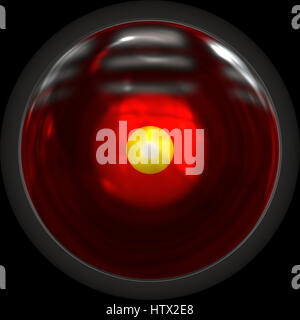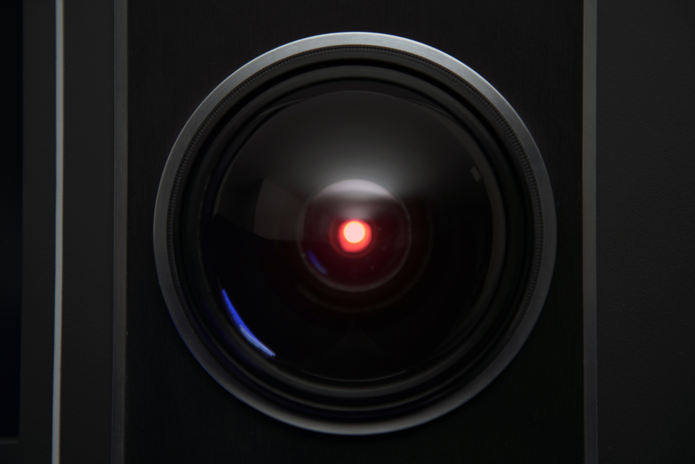

Rather than recreate the HAL voice however, I would love to have a Samuel Jackson voice system instead. For those with a twisted sense of humor and have one of those camera-equipped door bells, you could mount that camera behind this plate and talk to unsuspecting visitors through your HAL 9000 faceplate. Total time for this project was about 1/2 day, including masking, painting, decals, and assembly. This was a fun project and just what I needed to get my modeling mojo moving once again. I've got the wall plate dry-fitted to the base plate/display stand for these photos, but I'll likely hang this one in my office soon. The power switch drops into the slot on the side of the frame and a 9-volt battery was snapped into the connector and placed at the bottom of the wall plate.

I inserted the red LED into the hole in the back of the lens assembly and it didn't want to come back out, so no glue was used here. Next comes the electronics, which comes out of the bag pre-wired and ready to go. The lens assembly goes into the wall plate along with the speaker grill.

The instructions suggest white glue, which is a good idea, though I used Tamiya Extra Thin Cement to build this model, being careful to not craze the clear parts. Using a microfiber cloth, I carefully wiped the lens domes of any dust or debris (it is very dry this time of year and static electricity is present) before gluing the domes into place. The decal for HAL 9000 and the markings for the lens were applied before the lens assembly went together. Instead, I used a 3000 grit sanding stick and removed the paint from the lettering and it achieves a very good look (for me at least). The stand has '2001: a space odyssey' molded on it with good relief, though the instructions suggest painting the lettering white. The speaker plate was painted Tamiya Gun Metal. The main wall plate was masked and painted Tamiya Flat Aluminum as was the lens frame. Aside from the clear lenses, all of the parts were primed with black Stynylrez. The parts layout is very nicely engineered to make painting easy, so that's where I started. While I want to put a few of these up around the house (fortunately, the spousal unit is also a sci-fi geek), I thought I'd build one straight out of the box to see how it goes. You can see our first-look at the kit and its parts here. Even so, 2001 still feels futuristic today on the big screen while other movies lose their futuristic feel within a few years thanks to advances in consumer electronics.Ī few weeks ago, Moebius Models released their long-awaited HAL 9000 terminal kit. HAL's user terminal concept is done today with devices like Alexa, and we've moved so far beyond with distributed computing using miniature computers inside smart phones, tablets, laptops, etc. What Clark presented as HAL was indeed futuristic at the time though today, artificial intelligence has advanced significantly and centralized computing of the past is now distributed computing through networks around the globe. To put this into perspective, computers in 1968 were huge and kept in special climate-controlled rooms, usually in a building's basement, and interaction with these computers was through dumb computer terminals and programs were loaded using hundreds, if not thousands, of punch cards. As you'll recall from the movie, the crew interacts with HAL through wall-mounted modules equipped with camera, microphone, and speaker, as the computer itself was a massive affair kept in a special chamber aboard Discovery. Clark wrote the novel and screenplay for 2001: a space odyssey, one of the 'stars' was the HAL 9000 computer, HAL being an acronym for Heuristically-programmed ALgorithmic computer, heuristics in those days was one of the early foundations for what would become artificial intelligence.


 0 kommentar(er)
0 kommentar(er)
